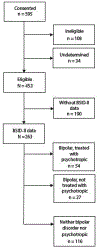One-Year Developmental Outcomes for Infants of Mothers With Bipolar Disorder
- PMID: 28068465
- PMCID: PMC7296817
- DOI: 10.4088/JCP.15m10535
One-Year Developmental Outcomes for Infants of Mothers With Bipolar Disorder
Abstract
Objective: Few data about the development of infants born to women with bipolar disorder have been published. We hypothesized that infants of women with bipolar disorder (by DSM-IV criteria) treated with psychotropics (BD+) or untreated with psychotropics (BD-) would demonstrate poorer cognitive and behavioral development than infants of controls. On the basis of previous studies, we expected that psychotropic-exposed infants of women in the BD+ group would have poorer neuromotor performance during infancy.
Methods: This longitudinal study included 197 mother-infant dyads recruited to participate between July 2006 and March 2011: 81 with prenatal maternal bipolar disorder without psychotropic treatment (BD-, n = 27) or bipolar disorder with psychotropic exposure (BD+, n = 54) and 116 in which infants were exposed to neither bipolar disorder nor psychotropics. Maternal psychopathology and pharmacotherapy exposure assessments were completed at 20, 30, and 36 prenatal weeks and 12, 26, and 52 weeks postpartum. Infants were evaluated with the Bayley Scales of Infant Development, Second Edition, which included the psychomotor (Psychomotor Development Index [PDI]), cognitive (Mental Development Index [MDI]), and behavioral (Behavioral Rating Scale [BRS]) components.
Results: Neither prenatal exposure to BD- or BD+ significantly impacted overall PDI (P = .2449), MDI (P = .7886), or BRS (P = .6072) scores. However, we observed a significant effect of BD+ exposure-by-time interaction for the BRS Motor Quality index (F₂₄₅ = 3.16, P = .0441), with BD+ exposed infants less likely to be above the 75th percentile at the 52-week assessment (mean = 11.5%) compared with BD- (mean = 40.0%) and nonexposed infants (mean = 48.4%).
Conclusions: We found no significant impact of prenatal BD- or BD+ exposure on infant PDI, MDI, or overall BRS scores at 12, 26, or 52 weeks of age, with most scores remaining within normal limits. Consistent with previous studies, we found a specific effect of prenatal BD+ exposure on quality of motor functioning at 1 year. However, the majority of infants were within normal limits on this developmental outcome.
Trial registration: ClinicalTrials.gov identifier: NCT00585702.
© Copyright 2017 Physicians Postgraduate Press, Inc.
Conflict of interest statement
Figures


References
-
- Kessler RC, Berglund P, Demler O, et al. Lifetime prevalence and age-of-onset distributions of DSM-IV disorders in the National Comorbidity Survey Replication. Arch Gen Psychiatry. 2005;62(6):593–602. - PubMed
-
- Yonkers KA, Wisner KL, Stowe Z, et al. Management of bipolar disorder during pregnancy and the postpartum period. Am J Psychiatry. 2004;161(4):608–620. - PubMed
-
- Leibenluft E Women with bipolar illness: clinical and research issues. Am J Psychiatry. 1996;153(2):163–173. - PubMed
-
- Viguera AC, Whitfield T, Baldessarini RJ, et al. Risk of recurrence in women with bipolar disorder during pregnancy: prospective study of mood stabilizer discontinuation. Am J Psychiatry. 2007;164(12):1817–1824, quiz 1923. - PubMed
Publication types
MeSH terms
Substances
Associated data
Grants and funding
LinkOut - more resources
Full Text Sources
Other Literature Sources
Medical

